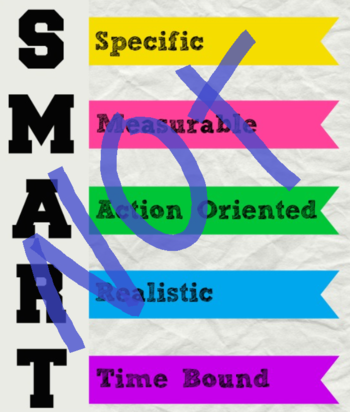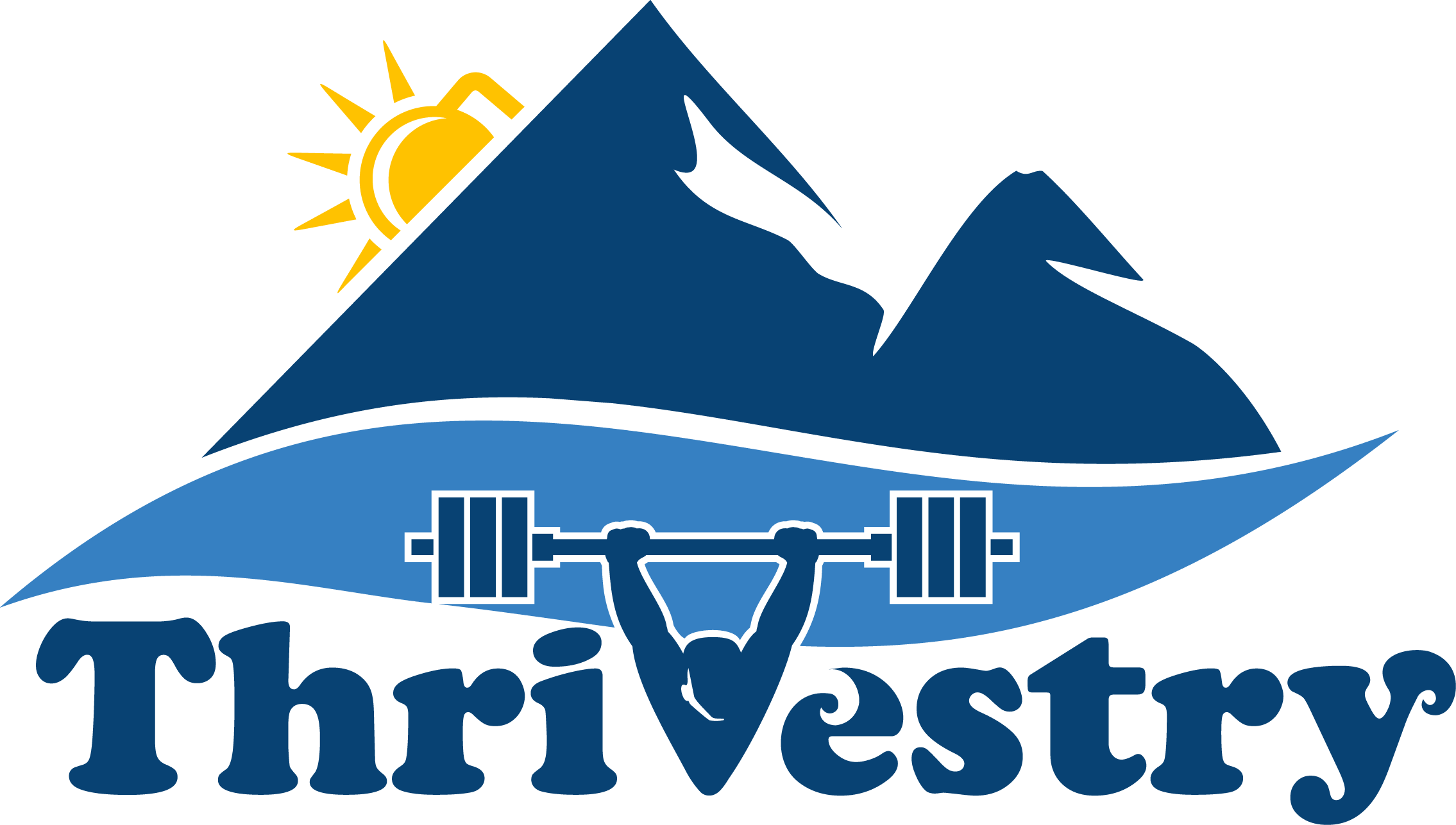When SMART goals can be really DUMB (with some bonus CrossFit related stuff)

Because it is THAT time of year, I am pulling out an updated article I wrote a few years ago. It started with a question from Brian:
Hi Jeremy
A few people been bringing up to me about their 2016 goals and requested of running a Goal setting seminar this Saturday as Saturdays is a big traditional team workout day at our community where everyone brings their friends.
Was wondering if you have any notes or suggestions for the points to address during this seminar. In the past, i would help everyone make their goals S.M.A.R.T and then help each of them with proper progressions on how they can reach their goals. But I’m sure there is way more to the seminar than that.
If you can provide some more ideas for me that would be greatly appreciated.
Thanks so much.
Sincerely
Brian
Hey Brian!
Goals without a strategy are just wishes with a deadline. Strategies without routines are just theories without action.
Basically it is good to have SMART goals, but the next step is to break them down into deeper purpose, prioritize each, then come up with time based checkpoints (micro goals), and break it down further to daily and weekly habits.
Purpose: Ask Why at least three times.
“Why do you want to do that?”… “And why is that?” … “AAAND why is that important to you?”
Goals without meaning will not be adhered to. If someone wants to floss or get a muscle up, they had better WANT the results. Asking why at least 3 times (5 is better), is a great way to get to the heart of the matter and help people focus on what the real reason is why they are doing it.
Have everyone write down their answers to the Why’s so that it is in black and white.
Prioritize: Which results are the most important to you?
There will be days and weeks where it will be hard to stay on track. Listing your goals in order of priority will help you make better choices about which ones to put the limited amount of time or effort behind.
Depending on the size of the goal, you may want to cross off all but the top one or two and focus on those first. Achieving one important goal is more motivating than getting 20% on 5 goals.
Micro Goals: Monthly or quarterly checkpoints.
After you have set your long term goals, determined why they are important, and prioritized them, you need to break them up into smaller chunks. If you want to add 50lbs to your back squat in the next 6 months, that means you need to add 8-10lbs a month. Is that feasible for you? What is the strategy that will get you to that goal?
Setting checkpoints (and putting them on your calendar with reminders), will make larger goals seem more manageable and also give you a reality check if you have too many checkpoints across too many goals. It can be a time re-evaluate the timeline or results you are looking for.
This is also the section where goals should be broken down into their smaller steps/components. Before doing a muscle up, the ring dip needs to be mastered. Before doing 100 double unders unbroken, 100 single unders must be completed.
Habits: “You are what you repeatedly do.”
Ultimately this brings us to the most important part about goals (and back to the original quote above). No goal will be achieved without routine and habits. Once we know the smaller checkpoints and checklists to accomplish a monumental task, we can determine what weekly and daily habits can get us there.
That is what we are doing in the gym every day. We are making people do the little stuff every week that will make them stronger, fitter, healthier, better looking, and more awesome!
Now if they have a more specific goal of losing some pounds of fat, it will come down to the daily habits that will move them down that path. Simply picking the goal of losing 15lbs in the next 3 months, and then scheduling the loss of 1-2lbs per week isn’t going to be very successful.
Analyzing your strengths and weaknesses regarding the goal, then picking out which habits will give you the most ‘bang for your buck’ will produce much greater results. In the fat loss example, eating a protein and vegetable at breakfast every day, stopping all caloric drinks, and doing meal prep each week are habits that will get you to your micro goals. If you don’t hit your micro goals, then it is time to do a course correction and introduce new habits, tighten up current ones, or even re-evaluate your timelines.
Goals for CrossFitters
We’ve always had great success breaking our athletes’ goals into three categories:
· A gymnastics/bodyweight goal
· A strength/weightlifting goal
· A metabolic/monostructural goal
Gymnastics / Bodyweight
These goals include things like 20 unbroken pull ups, 1st muscle up, handstand walk 50’, etc. These skills are usually very technical, require skill progressions, and are usually repetition based (not strength based, see below).
Strength / Weightlifting
These goals are things like a double bodyweight back squat, snatch 100 kilos, 1 strict full deficit handstand push up on paralletes, 1st pull up, etc. They aren’t confined to the barbell only. They can include movements that are bodyweight, but demand a high level of strength.
Metabolic / Monostructural
These goals are things like 50 unbroken wall balls, a sub 6 min mile, a sub 4 Fran, 100 unbroken double unders, etc. These skills are generally higher rep, lower technical skill, but generally come down to a high level of efficiency.
Each athlete is responsible for coming up with one from each category, and then picking which one is the most important. We have athletes write these down on a huge whiteboard in the gym and leave it up all year long. When we do “Year End Goal” and Max Effort testing days, it is easy for the coach to walk over and call people out on their goals. New athletes can add to it all throughout the year. When someone finishes a goal, they get to ring a big bell and mark off their Y.E.G. on the whiteboard.
BONUS: An App That Gamifies Your Habits!
Here is a neat little free app that can help people stick with their habits: Habitica
I dabbled with this in the past and I really liked it. I haven’t had the chance to join any “Quests” or really add too much to my avatar yet, but it is has been interesting setting up my daily habits and ranking them. I started out with too much (which was an important realization in and of itself), and now I am approaching it a bit more slowly.
In the future, I could see many coaches and gyms using this as a fun tool to get clients to focus on their goals and hold each other accountable. Let me know if you guys start using and have any tips for how to use this to help people learn how to thrive!
And there you have it. Here is the summary:
1. Find the true purpose of the goal. Ask “Why” three times at least.
2. Prioritize. Which goal is most important? Make time to do the important stuff.
3. Break it down. Monthly and Quarterly checkpoints and checklists. Use a calendar and have it ping you.
4. Make it stick. Create habits and routines that will carry you toward your goals on a daily and weekly basis.
BONUS ROUND: Set reminders of your 'whys' and review progress. Two ways you can make sure you stay on track is to have reminders pop up on your calendar (or sticky notes around the house), that remind you of why this is so important to you. It is also good to look back to where you started to be more aware of how far you have come (always looking 'forward' to how far you have to go is usually more demotivating than seeing how much better you are).
I hope this helps you get your people on track and making great progress this year!
Thrive on.
-jj
FOLLOW UP:
This is so awesome Jeremy. Thanks so much for your guidance. I have created a power point deck for this. Hopefully will be able to communicate all of the important points to ensure everyone has a good grasp on their goals by properly forming new habits.
One question came up in my mind though as i was testing this for my own goals:
- what if someone just wanted to get a muscle up (for example) because he or she thought it was cool? And they just wanted to know that they could do it?would it be less or a purpose?
- is there such a thing as a less meaningful purpose?
- what if someone just wanted to lose weight? And really didn't care about their fitness. All they wanted to see was 55kg on the scale (real story). How do you engage these guys properly?
Thanks again for all of this.
Brian
Great questions Brian!
For the depth of the questioning, I would ask why they think it was 'cool' or why is it important for them to feel like they could do it. There is sometimes a lot more to the story.
Occasionally, going deep on these will make them choose a different goal that is more meaningful for them.
If they do just pick something that is just 'fun' or 'cool', that is fine. It will help them prioritize one of their other goals ahead of that one.
As for the weight loss client, it can be difficult -but not impossible- to change their thinking about this. This is where asking "why do you want to see the scale there" is so important.
It takes practice because you don't want to be annoying about it or go too far into someone's personal issues if they aren't prepared to go there. But if you can figure out what the real issue is, AND show it to them, you can really help deliver the service that will make them a client for life.
To go into a bit more detail, when someone says I want to weigh xxx, I usually ask "Why do you want to weigh that? Are you a jockey that rides horses? An MMA fighter trying to make weight?" Generally people want to weigh a specific amount because they think that is the weight they'll be happy with their body (they won't usually).
So they really don't care about the weight, they care about how they look. So then you can ask: "Why does looking like that matter so much to you?"...
When they realize the real root reason for a goal, they can plan for it better and they'll have an easier time sticking to the daily and weekly routines.
Good Luck!
-jj
Sign up here to receive more articles about having a great life, coaching people how to have a great life, and CrossFit Programming.
Click here to check out our free tools and pricing options
And here are a few books on willpower and setting habits. I enjoyed them all and they have helped me shape my own life as well as help others shape theirs!
The Power of Habit: Why we do what we do in life and business
Influencer: The new science in leading change
The Willpower Instinct: How Self Control Works
Willpower: Rediscovering the Greatest Human Strength
:

0 comments
Leave a comment